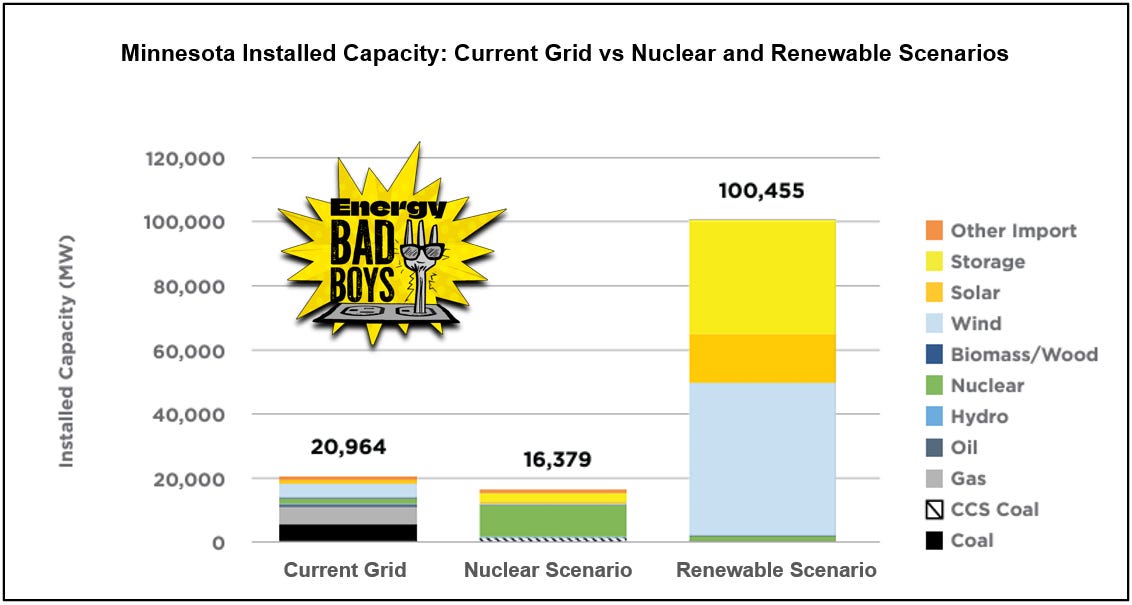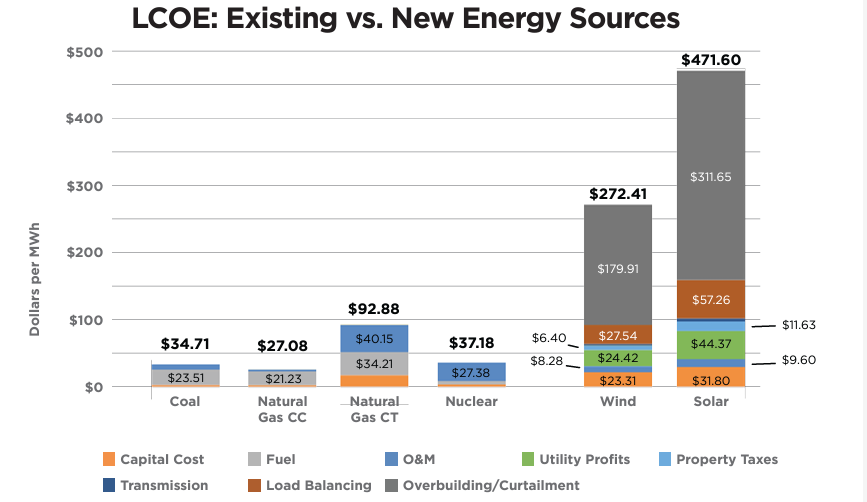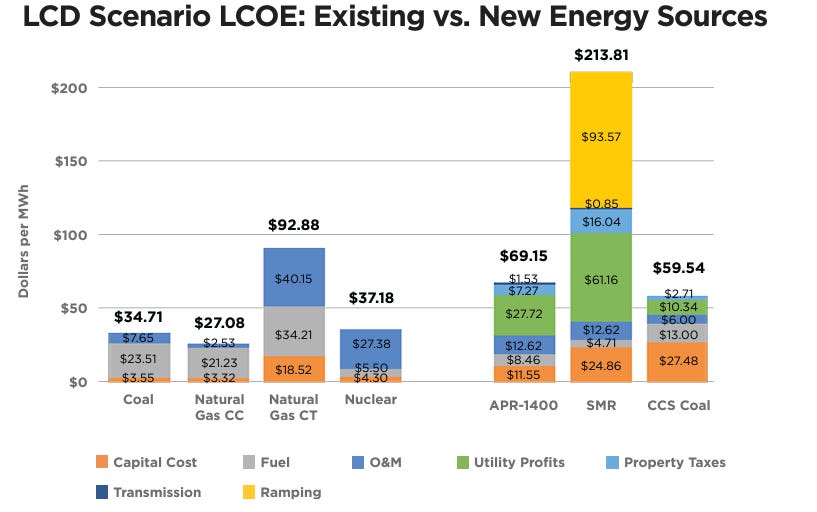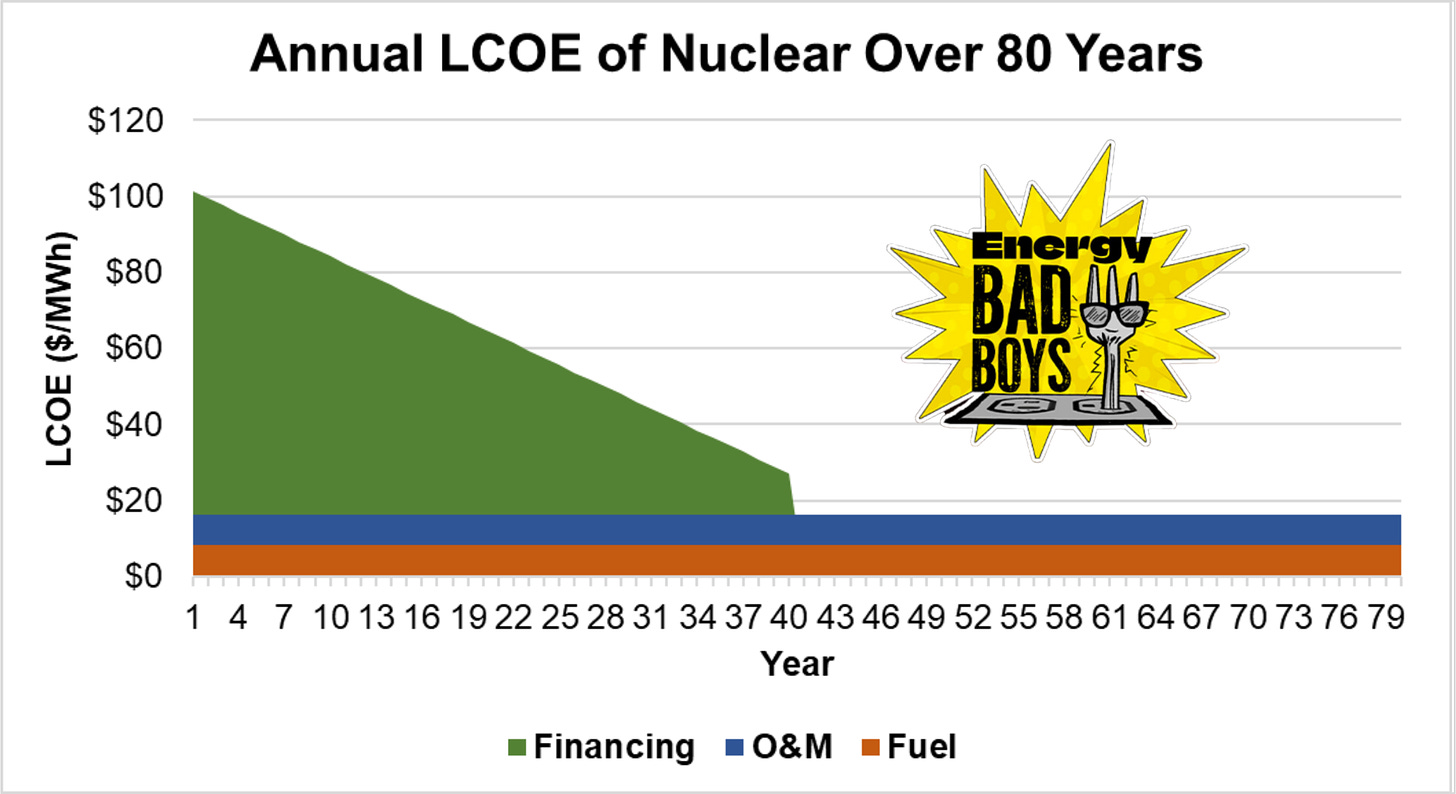Wind and solar supporters have a nasty habit of pretending that their preferred energy sources are the “cheapest forms of energy.” The problem, of course, is that they use unrealistic Levelized Cost of Energy (LCOE) estimates—see Cooking the Books for wind and solar—and they conveniently forget to mention the large system costs needed to reliably serve electricity demand using these unreliable energy sources.
That’s why, despite its high up-front capital costs, powering an electric grid with nuclear power is cheaper than using wind, solar, and battery storage.
Before we jump into the benefits of nuclear power, it’s important for our readers to understand that building a fleet of nuclear power plants will be very expensive, which will increase costs for ratepayers. A forced energy transition of any kind is going to increase costs inherently, and nuclear is no different.
If your main priority is reliable, low-cost power, keeping the existing coal and natural gas plants online and building new natural gas plants as needed will be the more affordable option. If decarbonizing the electric grid is your main priority, building new nuclear power plants will deliver a superior value to electricity customers, with reliable service at a lower cost than a grid powered largely by wind, solar, and battery storage.
The Benefits of Nuclear Power
American energy policy has been focused on “transitioning” to so-called cleaner energy sources for a number of years. However, even nuclear plants have fallen victim to this transition, even though they are the most reliable source of emission-less generation.
Nuclear power plants are a proven baseload and emission-free technology with the potential to offer low-cost electricity for decades longer than wind, solar, and battery storage facilities. As such, nuclear power plants are a much better replacement for coal or natural gas plants than wind, solar, and battery storage because they are reliable, inexpensive, and last a long time.
Below, we highlight a couple of the most important benefits of nuclear power and why it is, in fact, lower cost than wind and solar. This will show why energy policy in the states should be more focused on nuclear energy than wind and solar if policymakers are serious about reducing emissions reliably and affordably.
Dispatchability is King
Our definition of a reliable generator is dispatchability, meaning the unit can be turned on or off as needed.
Because nuclear plants are dispatchable, they don’t require backup generators or batteries like wind and solar facilities, and there is no need to overbuild and curtail the plants to ensure there is enough electricity available when the wind isn’t blowing very hard, or the sun isn’t shining.
In our 2022 report on the cost of Minnesota’s 100 percent carbon-free electricity mandate by 2040, we found meeting Minnesota’s electricity demand would require 100,455 megawatts (MW) of installed capacity under the renewable scenario. In contrast, this same job could be done by just 16,379 MW of new and existing nuclear plants, some battery storage, and retrofitting a North Dakota coal plant with carbon capture and storage technology.

Building excess wind, solar, and battery storage capacity in the Renewable Scenario was necessary to keep the lights on during periods of low wind and solar output, but it was also very expensive.
As part of our modeling, we analyzed the “all-in” system cost of each energy source, which is a much better representation of the cost of serving load than traditional Levelized Cost of Energy (LCOE) values, which leave out the cost of keeping the lights on with intermittent sources.
Our modeling found the additional costs of battery storage, referred to as “load balancing” in our report, and overbuilding and curtailment resulted in wind costing $272 per megawatt-hour (MWh) and solar costing $471 per MWh.

Meeting electricity demand with new nuclear power plants was much cheaper.
We modeled the cost of the APR-1400, a South Korean reactor, and found the cost of serving load was $69 per MWh. Small modular reactors (SMRs), based on EIA cost estimates, were modeled to generate electricity for $213 per MWh if used as peaking resources and $120 per MWh if used in a baseload capacity.1

Additionally, it’s important to note that the costs for new nuclear plants above are only for the duration of the model, which was through 2040. As will be shown below, these costs would decrease over time, unlike wind and solar facilities.
Nuclear is Very Cheap…In the Long Run
The other main benefit of nuclear power plants is their longevity, making them a long-term value play.
Nuclear plants are initially licensed for 40 years and can apply for 20-year extensions thereafter. For example, in its Integrated Resource Plan, Arizona Public Service assumes a 40-year book life for nuclear power plants. However, nuclear plants can last twice as long as this estimate, and a growing number of nuclear plants have applied to operate for 80 years, allowing them to generate very cheap electricity for decades.
The main cost for a nuclear plant is paying down the upfront capital cost of the plant. In a way, building a nuclear plant is a lot like taking out a big mortgage on a house. As you pay it off, it becomes cheaper to live there. When the mortgage is fully paid, the house is a very low-cost place to live. It’s the same with a power plant.
The graph below shows the annual cost of electricity from a nuclear power plant. The costs in the initial years are high, but once the capital costs are paid off, the only costs are fuel and operating expenses.
Nuclear is Lower Cost than Wind and Solar
The benefits of nuclear power - mainly, its dispatchability and longevity - result in far lower system costs than wind and solar.
We see this all the time in the real world. FERC Form 1 data consistently show existing nuclear plants generating electricity for $20.15 per MWh in Virginia, $21.71 per MWh in North Carolina, $37 per MWh in Minnesota, and $26.19 per MWh nationwide. Even without accounting for the system cost of incorporating wind and solar onto the system, the existing nuclear fleet in America is less expensive than existing wind and solar facilities, which cost $52 per MWh and $73 per MWh, respectively, according to FERC Form 1 data.
Conclusion
Nuclear power plants provide a superior value to consumers relative to wind and solar because of their dispatchable characteristics. This means less installed capacity can serve more load, more predictably. This eliminates the need for backup generators and overbuilding and curtailment.
Not accounting for system costs when considering which energy sources to build on the grid is one of the most egregious oversights in the energy industry, one that has led to incredible inefficiency and rising energy costs for many Americans.
When one does consider system costs and long-term value, nuclear plants are by far the most affordable carbon-free energy source that gives energy consumers the most bang for their buck. If the ongoing “energy transition” were serious, it would allow for more realistic timelines that stretch many decades into the future and the replacement of retiring coal plants more naturally with nuclear plants - instead of the premature retirements before suitable replacement capacity can even come online, as we have seen thus far.
Climate Fueled Extreme Weather by
Professor Alar Konist: Our Energy Policies Should Not Go From One Extreme To The Other by
The cost estimates of nuclear plants have almost certainly increased since we wrote the report in 2022, due to rising costs for materials, labor, and interest rates. These are the same factors that have caused wind and solar prices to climb in recent years.









Good article on costs. Costs is a topic which is not discussed in the energy transition. As someone who has worked in the energy business for nearly 50 years I will add a point which very few people seem to understand about energy costs and the economy . Everyone believes the economy runs on interest rates it really runs on affordable energy. Nearly every recession for the last 50 years was preceded by a spike in oil prices. Higher energy prices will lead to an economic collapse.
Excellent summary. However, your all solar and wind model for Minnesota would be inherently unstable, even with batteries. Any power grid requires a significant amount of synchronous grid inertia (SGI) for system stability. The GreenNUKE March 4, 2024 Substack article introduces the topic in a nontechnical manner. See: "Why is Grid Inertia Important? - Without sufficient synchronous grid inertia, the grid becomes unstable and a blackout occurs." https://greennuke.substack.com/p/why-is-grid-inertia-important Clearly, the nuclear power-centric grid would be economical, emission-free, reliable, and have sufficient SGI.